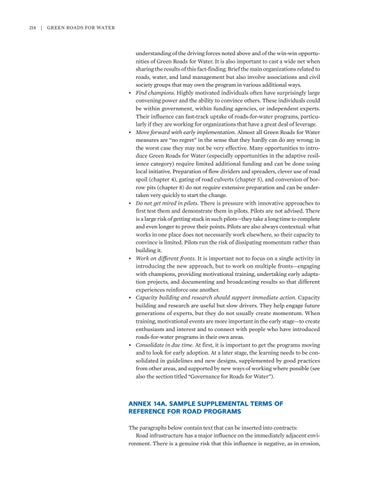214 | Green Roads for Water
•
•
•
•
•
•
understanding of the driving forces noted above and of the win-win opportunities of Green Roads for Water. It is also important to cast a wide net when sharing the results of this fact-finding. Brief the main organizations related to roads, water, and land management but also involve associations and civil society groups that may own the program in various additional ways. Find champions. Highly motivated individuals often have surprisingly large convening power and the ability to convince others. These individuals could be within government, within funding agencies, or independent experts. Their influence can fast-track uptake of roads-for-water programs, particularly if they are working for organizations that have a great deal of leverage. Move forward with early implementation. Almost all Green Roads for Water measures are “no regret” in the sense that they hardly can do any wrong; in the worst case they may not be very effective. Many opportunities to introduce Green Roads for Water (especially opportunities in the adaptive resilience category) require limited additional funding and can be done using local initiative. Preparation of flow dividers and spreaders, clever use of road spoil (chapter 4), gating of road culverts (chapter 5), and conversion of borrow pits (chapter 8) do not require extensive preparation and can be undertaken very quickly to start the change. Do not get mired in pilots. There is pressure with innovative approaches to first test them and demonstrate them in pilots. Pilots are not advised. There is a large risk of getting stuck in such pilots—they take a long time to complete and even longer to prove their points. Pilots are also always contextual: what works in one place does not necessarily work elsewhere, so their capacity to convince is limited. Pilots run the risk of dissipating momentum rather than building it. Work on different fronts. It is important not to focus on a single activity in introducing the new approach, but to work on multiple fronts—engaging with champions, providing motivational training, undertaking early adaptation projects, and documenting and broadcasting results so that different experiences reinforce one another. Capacity building and research should support immediate action. Capacity building and research are useful but slow drivers. They help engage future generations of experts, but they do not usually create momentum. When training, motivational events are more important in the early stage—to create enthusiasm and interest and to connect with people who have introduced roads-for-water programs in their own areas. Consolidate in due time. At first, it is important to get the programs moving and to look for early adoption. At a later stage, the learning needs to be consolidated in guidelines and new designs, supplemented by good practices from other areas, and supported by new ways of working where possible (see also the section titled “Governance for Roads for Water”).
ANNEX 14A. SAMPLE SUPPLEMENTAL TERMS OF REFERENCE FOR ROAD PROGRAMS The paragraphs below contain text that can be inserted into contracts: Road infrastructure has a major influence on the immediately adjacent environment. There is a genuine risk that this influence is negative, as in erosion,







































